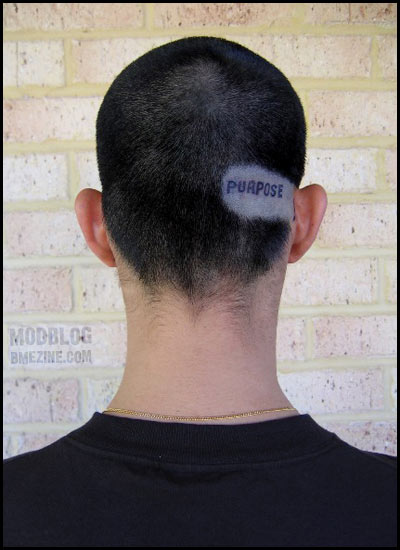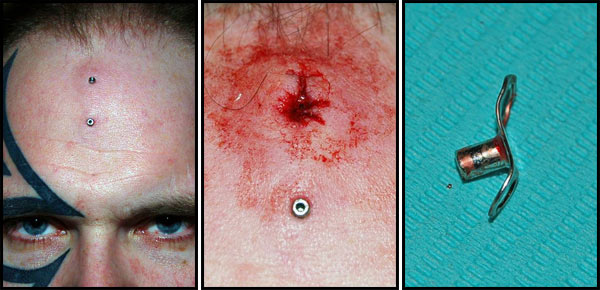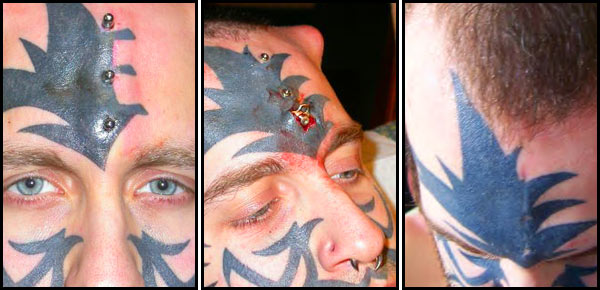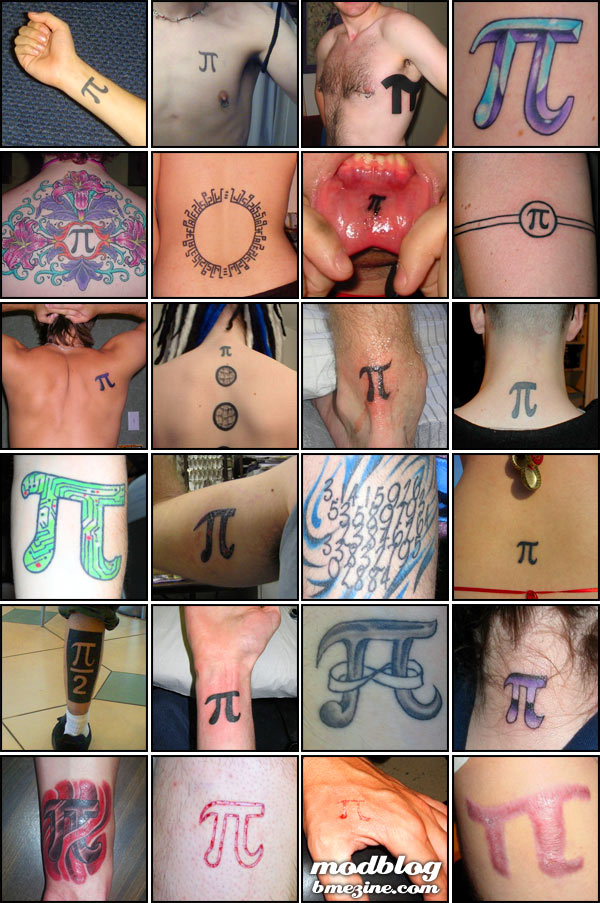
Post navigation
Now that’s a tattoo with meaning!
I mean, purpose!

By Duke at Boss Tattoo Studios, Canning Highway, Applecross, Western Australia.
More than one way to skin a cat!
So you may remember that a few days ago I posted a very radical transdermal strip removal that involved a very large amount of tissue being removed, with the motivating factor being dealing with large bald spots that had formed around the transdermals. Anyway, it created quite the furor in the entry, with many people feeling that too much tissue had been removed. Now, personally, I actually didn’t think it was all that bad a method, but in fairness I think it’s also important to post what more conservative practitioners felt a safer removal would be.
Steve Truitt just took out J5th‘s top transdermal (five years old) and he wanted me to show that the removals can be done far less invasively… What’s funny is when he took it out, it was all bent! I guess he took a blow to the head some time ago and didn’t even know it had damaged the transdermal! Apparently he has a hard head.

In terms of relating this to the larger removal posted earlier, this method would not address the baldspots of course and I believe has slightly more potential for scarring (assuming good healing in both cases), but it does involve hugely less risk to the client and practitioner and there’s a lot to be said for not risking seriously injuring your friends. The one above is fresh, and a smaller transdermal design, so let me also share the removal that Steve did on _Stigmata_, since I have a healed shot of that:

Anyway, bring on the yelling about it all. 🙂
BME Newsfeed for Mar 14, 2007
- 2007-03-14: PA: Tattoo views bring unexpected deluge by readers [by Eyeball Kid]
- 2007-03-14: MD: The War at Home: Reminders for those who cant forget [by Eyeball Kid]
- 2007-03-14: OH: Police Blotter [by deadly pale]
- 2007-03-14: BC: Permanent damage found in temporary tattoos [by Ribibe]
- 2007-03-14: CO: Tattoo revelation shows a mother’s not-so wild side [by Ribibe]
- 2007-03-14: UK: I’ll tattoo my bum [by Ribibe]
- 2007-03-14: IL: ‘CHI-TONW’ tattoos all the rage in Chicago [by Ribibe]
- 2007-03-14: CA: Furor leaves mark on doctor [by Ribibe]
- 2007-03-14: UK: City women baring all on body image [by deadly pale]
- 2007-03-14: MN: Bill gives parents more power over piercings [by Eyeball Kid]
- 2007-03-14: NF: Cleanliness is good business [by Eyeball Kid]
- 2007-03-14: MN: Bill gives parents more power over piercings [by deadly pale]
- 2007-03-14: CA: Tattooed Mom Accuses Doctor Of Discrimination [by Ribibe]
- 2007-03-14: CA: Wild Bill’s tattoo fundraiser [by Ribibe]
- 2007-03-14: OK: Judge prohibits fines of tattoo shops over surety bond [by Eyeball Kid]
- 2007-03-14: OR: New tattoo store opens in Fruitland [by Ribibe]
- 2007-03-14: OK: Tattoo shops hold off health department [by Ribibe]
Please note that links may expire. IAM members, please help out by submitting stories!
Deep down and skewery
As a quick follow-up to Shannon’s interview with “The Indestructible Man“, here’s a video cocktail of Dan skewering the entire length of his forearm and Captain Howdy (minus his flying circus this time) undergoing some acupuncture treatment for a dodgy tummy.
[Javascript required to view Flash movie, please turn it on and refresh this page]
Is Body Jewelry Quality Important?
This is a new section that I’m adding to ModBlog in which we talk to some of the best artists around the world about the nuances of the business of being not just good at what you do, but great. In this first column, we’ll be talking about jewelry — does it really make a difference if you’re using generic “316LVM” versus something that’s “ASTM-spec”? Is titanium really better? Is threading important? What if someone brings in their own jewelry?
I thought this would be a good one to start with, given the recent example of the kid who thought chain links would make acceptable jewelry!
In today’s column, commentary comes from (shown left to right below), Patrick Bartholomew (a mostly retired piercing pioneer who you may know from the London Piercing Clinic, and can be found at iam:PatrickB), Tom Brazda (iam:TomBrazda, TomBrazda.com, former owner and head piercer of Stainless Studios, now doing research and development into new body modification technologies and aftercare at BodyArt Pro), “Moddoctor” (iam:Moddoctor (a practising physician in the United States that is primarily a cosmetic surgeon but who also does piercing), and Leo Ziebol (iam:5point, co-owner of 5pointstudios)

PATRICK BARTHOLOMEW:
After fighting a running battle with rejection from allergies to stainless steel jewellery I finally stopped using it in fresh piercings on the first of January, 1992. I changed to titanium, and I have stayed with it ever since. With the steel I would have an average problem factor with rejection as high as twenty percent of all piercings, either minor “walking” out of alignment, or full rejection — with the Titanium it reduced to less than one piercing in four thousand. That was good enough for me. I also insist on supplying the initial jewellery.
TOM BRAZDA:
ASTM complient materials are designed to survive inside the human body and also release little to no toxic elements. These standards are changed as new information comes to light. If it does not comply with these standards then its considered a “commercial” grade material.
But material alone does not make a good piece of jewelry — you need a good smooth surface finish since the surface of the jewelry is what will be in contact with the healing tissue. If it’s not truly smooth it will increase scarring during the healing process by abrading the tissue as it moves around. The balls on the jewelry whether, it’s a barbell or captive need to be held on well and not come loose easily. The edges of the ring or barbell need to be rounded and smooth as well so that there is no sharp edge being pushed against the tissue.
The internal/external issue is a tough one since I’ve seen crappily made internals and well thought out externals. Whats important is what is in contact with the tissue during a jewelry insertion. Any sharp edge will cause damage.
Titanium is better in the sense that the tissue growth around it is not as dense as the tissue that forms around stainless, and since it’s lighter it’s better in heavier gauge piercings. But there are people out there that are sensitive to titanium, just like there are people sensitive to nickel. What makes the biggest difference is how “passive” the surface layer of the jewelry is. This can be achieved well in both stainless and titanium with proper processing.
Finally, if a customer brings in a piece of jewelry, unless I know who made the jewelry, I won’t use it. Most of the time its not even an appropriate size to do that persons piercing. People don’t come in standard sizes so “standard” sized jewelry doesn’t work!
MODDOCTOR:
It’s pretty remarkable how little difference jewelry material often makes. People with no metal sensitivities can heal with anything it seems. You could pierce those people with a paperclip (not really!) and they would do fine. Other people, though, just refuse to heal with stainless jewelry and I have found that changing to titanium resolves those problems. That said, jewelry quality makes a big difference across the board. Cheap jewelry seems like it sticks in a healing piercing, which may be the result of less than smooth polished surfaces.
As for internal versus externally threaded, I definitely prefer using internally threaded. It’s easier to pass through a fresh piercing and jewelry changes are less traumatic even in a well healed hole.
LEO ZIEBOL:
When it comes to jewelry, I don’t know much about how different metal affect the body on a cellular level but I do know that I want to do everything I can to help that piercing heal as easily as possible. I have seen a lot of problems associated directly to poor jewelry. I’ve also seen some of the most god-aweful pieces of reconstituted tin can heal excellently. For me, using quality jewelry is another way that I minimize the chance factor. I will never eliminate it but I will do my best to keep it as low as possible.
It is rare that I will use jewelry brought in by a client. We have one other shop in our area that uses ASTM internals and I would gladly use a piece that was brought in from there as long as it wasn’t damaged or of improper size for that client. If I don’t know where it came from or what company made it, I won’t use it.
So… Four experienced piercers, one a piercing pioneer, and one a doctor, all appear to be in general agreement — not only is it important to seek out not only jewelry made of high quality materials that are inherently biocompatible, but that the finish of the jewelry is of equal importance (so even if jewelry is a good material, if it’s not well manufactured, it will still complicate thing). All quality studios should be able to tell you exactly what materials they are putting in you and who manufactured them. You may pay a little more, but really, would you rather pay $25 for a piercing that’s going to be irritated, take longer to heal, and potentially reject, or $50 for one with a solid shot of lasting a lifetime?
In the next installment of this column we’ll be talking about items a good studio should have, that too few people have gone to the effort to obtain.
A selection of Pi tattoos
OK, there’s a few Pi scars as well as lots of Pi tattoos (mostly from BME’s geek tattoo section) since today is 3/14… (What, if pirate day tattoos get a post, so can today!)

New Server Alive
If you can see this post, you’re seeing ModBlog on the new server… and you’re also seeing DeliaPsyche, pierced 134 times by Russ Foxx and her friends in Vancouver. Full blog returns tomorrow!

BME Newsfeed for Mar 13, 2007
- 2007-03-13: Australia: Tattoo artist wins $100000 portrait prize [by Ribibe]
- 2007-03-13: IL: ‘We’re not a bunch of idiots’: CHI-TONW their kind of tattoo [by Ribibe]
- 2007-03-13: ND: Bill will regulate tanning, tattoos [by Ribibe]
- 2007-03-13: FL: 5 things you didn’t know about body piercing and tattoos [by Ribibe]
- 2007-03-13: NY: Branded Babe [by Ribibe]
- 2007-03-13: IL: ‘CHI-TONW’ Tattoos Are The New Trend In Chicago [by Eyeball Kid]
- 2007-03-13: MO: Good reasons to get tattoos [by Ribibe]
Please note that links may expire. IAM members, please help out by submitting stories!
BME Newsfeed for Mar 12, 2007
- 2007-03-12: WA: The Art of Tattooing and Learning How to Tattoo Gaining Huge Popularity [by Eyeball Kid]
- 2007-03-12: NY: Tattoo shop: Focus on custom work [by Eyeball Kid]
- 2007-03-12: NY: Tattooed Torso Draws Similarities To Cold Case [by Ribibe]
- 2007-03-12: MN: Senate to vote on piercing bill [by Eyeball Kid]
- 2007-03-12: CA: Want to lose that tattoo? [by Eyeball Kid]
- 2007-03-12: CA: Redding nurse blasts away unwanted tattoos [by Ribibe]
- 2007-03-12: New Zealand: Lee to add Kiwi tattoo to collection [by Ribibe]
- 2007-03-12: MI: Council to vote on tattoo ordinance [by Ribibe]
Please note that links may expire. IAM members, please help out by submitting stories!